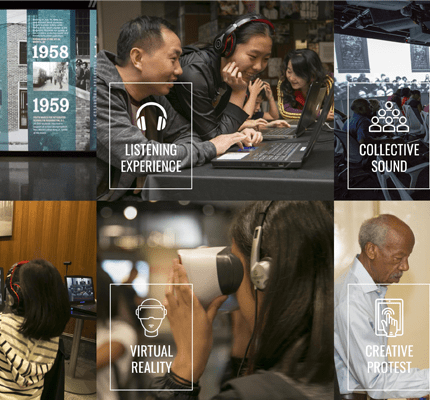
Using Digital Technology to Explore a Martin Luther King, Jr. Speech in the Public Speaking Classroom
Today’s students are often termed “digital natives” because they grew up with digital technologies. Thus, instructors frequently wonder how best to use technology to keep these students engaged and interested in learning. A new article published in NCA’s Communication Education addresses how Communication educators can use new technologies in innovative ways when teaching public speaking. Victoria J. Gallagher, Max M. Renner, and Ragan Glover-Rijkse examine the Virtual Martin Luther King, Jr. Project (vMLK), a re-enactment of Dr. King’s 1960 speech, “A Creative Protest.”
vMLK
Through vMLK, students experience Dr. King’s speech from the perspective of the audience, using advanced audio technology and digital projection in a lab or a virtual reality simulation. The original speech took place in February 1960 at a church in Durham, North Carolina, but the church at which Dr. King spoke no longer exists. In 2014, the speech was recreated at the church’s current sanctuary using a voice actor; a variety of people from the community attended, including original event attendees. According to Gallagher, Renner, and Glover-Rijkse, the goal of vMLK is to “engage this speech through presentation of six components: (1) historic context, (2) individual listening and (3) collective sound experiences, (4) virtual reality and (5) gaming platform experiences, and (6) the ‘your creative protest’ feedback opportunity.”
The Students’ Experience
North Carolina State University has used vMLK since 2015. Gallagher, Renner, and Glover-Rijkse collected comments from Communication students who used the resource in class during the 2018-2019 academic year. In preparation for the vMLK experience, students watched a documentary about the project and a documentary about the 1957 sit-in that served as historical context for the speech. Students experienced vMLK through a collective experience in a lab featuring a spatially differentiated surround sound audio of the speech and the congregation’s call and response and a visual projection of the sanctuary and the original audience. After watching/listening to the speech, they wrote responses to prompts, such as “A Creative protest is…” on white boards. Gallagher, Renner, and Glover-Rijkse categorized and analyzed 340 written responses from approximately 1,000 students.
The results showed that students felt immersed in the experience, particularly because they were able to virtually engage with the audience as part of the simulated congregation. One student wrote, “Through this experience you can really get a feel of how it would be if you were really there, you can hear the sincerity in his voice, overall it makes you understand the speech in a whole new and realistic way.” Students pointed to sound as a key element of the immersion. The ability to be immersed in a historical event led one student to write that they saw “the troubles of civil rights in a new light.”
Students also wrote about their experiences with the virtual space and how it felt “lifelike.” Describing the space, one student wrote, “it felt like I was in the church and directly listening to MLK. However, the crowd felt far away.” Another aspect of the immersive experience was the feeling of living through a historical event. Students could move around the virtual space to see and participate in the event from different vantage points in the church.
vMLK also contributed to students’ awareness of ongoing social and political movements related to racial justice. Dr. King’s “A Creative Protest” speech addresses the use of sit-ins as a form of political action. Thus, many of the students’ responses focused on protests and the importance of these protests. Students drew connections between the sit-ins and current social movements, such as the Black Lives Matter Movement. One student wrote that “[progress] should have happened earlier but now action is being taken.”
Gallagher, Renner, and Glover-Rijkse found that the students also appreciated the six components of the vMLK experience, including the introductory video documentary and archival materials. According to one student, “The context given prior to both the sound room and VR gave it all more meaning.” The context given through the components of the project contributed to students’ understanding of the event and to their understanding of the Civil Rights Movement more broadly. Reflecting on the whole vMLK experience, one student noted that it “is super profound, not only for civil rights but for the future of public speaking in general and recreating it in an authentic and moving way.”
Conclusion
Gallagher, Renner, and Glover-Rijkse argue that their analysis shows the vMLK project offered an immersive experience of Dr. King’s speech in which students found themselves taking on the role of the audience and comparing that historical moment to today’s continued struggles for justice and equality. vMLK demonstrates that virtual technologies can enhance learning opportunities in public speaking classrooms.




